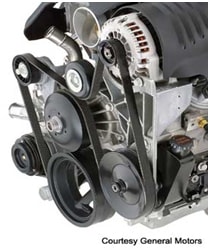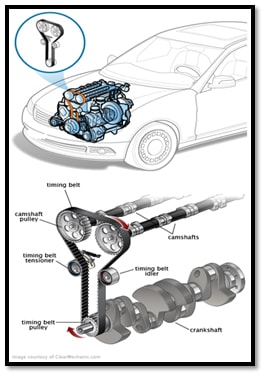Customers Ask Honest-1 (cont.)
It is important to know the types of belts in your car and a trustworthy guideline to when they should be replaced.
The two most frequent belts found in newer cars are the Serpentine Belt and the Timing Belt.
 I. Serpentine Belt: Using a series of grooved pulleys, the purpose of a serpentine belt is to run and power multiple parts of your vehicle including the power steering pump, alternator and air conditioning. These belts can be identified by their wide service area and lack of thickness.
I. Serpentine Belt: Using a series of grooved pulleys, the purpose of a serpentine belt is to run and power multiple parts of your vehicle including the power steering pump, alternator and air conditioning. These belts can be identified by their wide service area and lack of thickness.
Most experts recommend that you change your serpentine belt at least every 35,000 miles. However the best rule of thumb is to consult your owner?s manual and get this belt frequently inspected by a professional for any worn areas, cracks, or breaks. Living in the dry climate of Arizona, this becomes even more important. In addition, if you are noticing squealing from under the hood during start-up or problems with your A/C or power steering, it may be a worn, stretched, or broken belt. Honest-1 Auto Care professionals would be happy to visually inspect your serpentine belt at any time.
II.  Timing Belt: A timing belt is a toothed belt that connects the engine?s crankshaft and camshaft and is encased behind a protective covering. Basically, a timing belt synchronizes the camshaft to the crankshaft position allowing the valves to open and close at the proper timing in relation to the position of the pistons. In some engines a timing belt can also drive critical components including the water pump, injection pump and oil pump. To work properly, a timing belt must be under a certain tension which is often controlled by the timing belt tensioner. A worn belt may affect engine performance and a broken belt will stop the engine from running and possibly leave your car with severe internal engine damage. If you are hearing slapping or scraping noises from the engine or if the Check Engine Light is on with the camshaft or crankshaft trouble codes, you might have a worn or loose belt.
Timing Belt: A timing belt is a toothed belt that connects the engine?s crankshaft and camshaft and is encased behind a protective covering. Basically, a timing belt synchronizes the camshaft to the crankshaft position allowing the valves to open and close at the proper timing in relation to the position of the pistons. In some engines a timing belt can also drive critical components including the water pump, injection pump and oil pump. To work properly, a timing belt must be under a certain tension which is often controlled by the timing belt tensioner. A worn belt may affect engine performance and a broken belt will stop the engine from running and possibly leave your car with severe internal engine damage. If you are hearing slapping or scraping noises from the engine or if the Check Engine Light is on with the camshaft or crankshaft trouble codes, you might have a worn or loose belt.
Timing belts should be replaced at scheduled intervals, typically anywhere from 60,000 to 90,000 miles varying among car manufacturers. Your owner's manual will have your vehicle?s specific mileage recommendation. If you no longer have an owner?s manual, call Honest-1 and we can look it up for you.
Some car manufacturers have done away with timing belts and instead use timing chains. These function in the same way, but can last as long as the engine itself, therefore it does not need to be replaced unless there is a problem. If you do not know if your car has a timing belt of timing chain again your owner?s manual will give you that information or we would be happy to assist you!
At Honest-1, we want to ensure our customers are safe and their cars running trouble free. If you ever have any questions about your car?s belts, your manufacturer?s recommendations or any other part of your vehicle, please feel free to call us at 602-404-6785. We are here for you!